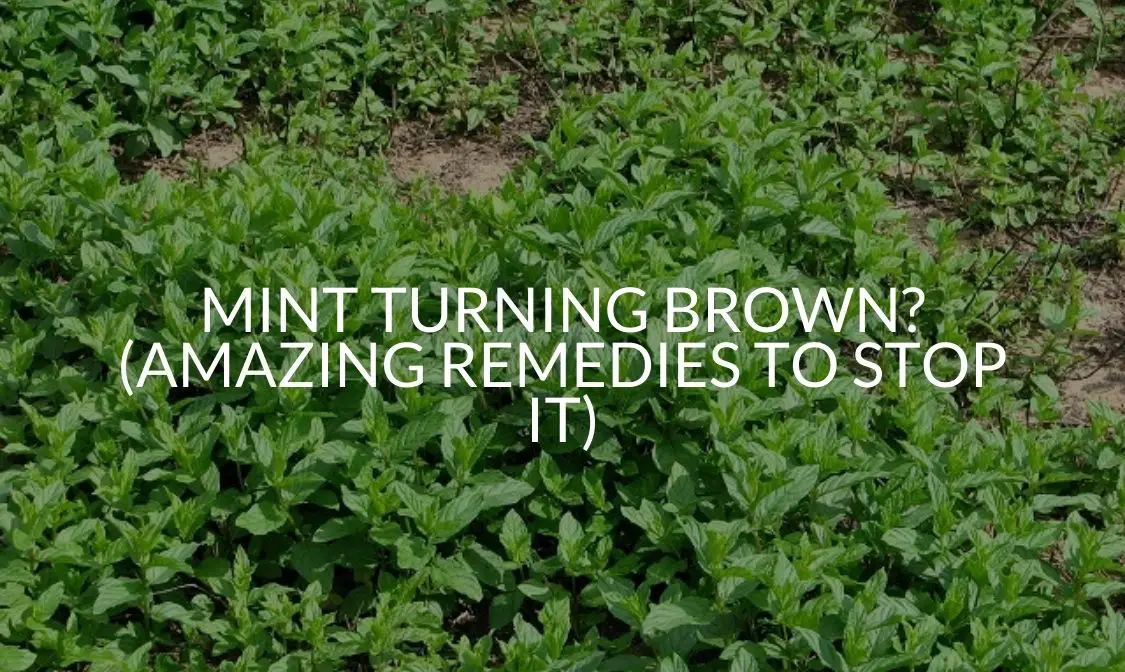Why is my mint turning brown? This seems to be a question that I asked myself repeatedly whenever I first started growing mint. After a lot of research and a process of trial and error, I finally started to learn how to diagnose and treat brown mint.
If you are having the same issue, you have come to the right place. In this article, we are going to look at what turns mint plants brown or yellow and brown and what to do about it. Let’s get started.
Why is My Mint Turning Brown?
Most often, mint turns brown because of heat scorching, improper watering, humidity, and diseases, like fungal infections. Mint can also turn brown due to nutrient deficiencies, limited roots, and aging, but these reasons are less likely to be the culprit.
Why Are My Mint Leaves Turning Brown?
The leaves are the most common part of any plant, including mint, that turn brown. Generally speaking, mint leaves can turn brown in two different ways. First, they can be brown and crispy looking. Second, they can just be brown around the edges. Let’s look at both of these scenarios individually.
Brown and Crispy Leaves
If you notice that your mint leaves are brown and crispy, no matter how much you water them, it might be because you are exposing your mint to too much sunlight.
This will most likely be true if you place it in direct contact with the sun. Mint does not thrive in this environment, and it will likely experience heat scorching as a result. Instead, mint does best in shadier conditions.
Luckily, this issue is pretty easy to fix. If the leaves are completely scorched, simply wait for them to fall off and protect the rest of the plant by placing it out of direct sunlight.
This issue can also be caused by too little humidity. Mint is fickle about humidity levels. If your plant is out of direct sunlight and you water it correctly, low humidity is to blame for this issue. Simply mist the leaves between watering to get enough humidity.
Brown Edges
If only the edges of your mint leaves are brown, then it is likely experiencing the opposite issue of a mint leaf with brown and crispy leaves. Brown edges typically mean that your plant is stressed and not getting enough water.
To fix this problem, start watering your mint plant a little bit more. As you water your mint, make sure to water it from the level of the soil. If you water it too high up, not all the water may reach the roots and it could potentially damage the leaves.
Why Are My Mint Leaves Turning Yellow And Brown?
In addition to leaves being completely brown, mint leaves can be brown and yellow. Whenever you see the leaves coated with yellow, it is likely because they have fungal rust. Fungal rust is one of the most common issues that gardeners face.
In most cases, fungal rust is caused by excess humidity around the leaves. Your plant may be exposed to excess humidity if the plants are placed too closely together, the environment is closed, or overhead irrigation drops water on the plant leaves.
Treatment Options
To treat fungal rust, you need to destroy the infected leaves. If you don’t do this, the fungal rust will spread to the other leaves and eventually destroy the entire plant. Additionally, apply a fungicide to the soil and irrigate it a bit.
You can also create a homemade solution to treat the fungal disease using neem oil. Simply mix 2 tablespoons of neem oil within 1 gallon of water. Then, spray the entire plant, including the bottom of the leaves, with the solution until the plant is thoroughly wet.
If you don’t have neem oil, you can also use baking soda. Mix 1 teaspoon of baking soda in 1 quart of water. Additionally, add a few drops of liquid dish soap. Spray the solution on the foliage of the plant.
After you treat the plant, ensure that it has proper airflow. This airflow will prevent excess humidity from building up, protecting your plant in the future.
Why Are My Mint Plants Stems Turning Brown?
The most common reason that mint plant stems turn brown is bacterial blight. This bacterial infection will start with the plant’s primary stem. If it goes on long enough, it will eventually kill the leaves as well. This bacterial infection typically reaches mint from other house plants.
Treatment Options
To treat this bacterial issue, you need to prune all affected twigs. Prune them about 8 to 12 inches below the observable symptoms. After you prune the plant, disinfect the pruning shears by soaking them in a solution made of 10% bleach or alcohol. Leave the shears there for 30 minutes.
If the mint plant is not big enough to prune properly, you can use a fungicide. Use a fungicide that contains copper and mancozeb. Apply the fungicide every 7 days or so. You should only need to apply it for 2 or 3 weeks.
How To Stop Mint Leaves Turning Brown
If you notice that your mint leaves are turning brown, the first thing to do is to determine why the mint leaves are turning that color. As we learned above, a variety of reasons can make the mint leaves change. The easiest way to determine why your mint is turning brown is to look at where the coloration is occurring and how the rest of the plant feels.
Once you know why your mint plant is turning brown, address the issue accordingly. Above, we detailed a number of ways to treat an ill mint plant according to the issue.
In some cases, you won’t be able to reverse the effects on individual leaves. For example, leaves that are turned brown because of fungus and bacteria need to be removed immediately and should not be rehabilitated. For a stressed plant, however, upping the water should prevent the mint leaves from turning anymore brown.
You also need to start treating the rest of the plant a little bit better so that the entire plant doesn’t turn brown and die. You can do this by treating the issue and following through with some of our preventative tips below.
How To Prevent Mint Leaves Turning Brown
If you want to ensure your mint plant doesn’t turn brown in the future, make sure that you’re providing your plant with the perfect environment and watering schedule.
Create The Perfect Environment
First, make sure to place your mint plant in the proper location. As we explained above, mint does not need to be placed directly in sunlight. This can lead to scorching, which will cause your mint leaves to turn brown and eventually die.
Instead, place your mint plant in a shady area where it gets a lot of indirect but very little direct sunlight. This will allow your mint plant to undergo a healthy amount of photosynthesis without being scorched.
Additionally, anticipate rotating your plant every three to four days. This will help the plant to have an even appearance and not become lopsided. It will also prevent any leaves from potentially becoming scorched or exposed to too much sunlight.
Another important factor to consider is humidity. Too much humidity can cause fungus and bacteria to flourish. Fungus and bacteria are some quick ways to get brown leaves and a dead mint plant. Prevent this from occurring by monitoring humidity levels.
For best results, make sure that there are no sources for water to drip on the plant repeatedly. More so, space the mint plants out about 5 inches apart so that they can get proper ventilation and airflow. This will prevent the mint plants from having too much humidity.
At the same time, mint plants do like a little bit of humidity. Between watering, you can mist the plant gently. Another idea is to set your container of mints on a tray filled with water and pebbles. Both these techniques will ensure that the mint plant gets just the right amount of humidity.
Water Consistently
As with any plant, mint needs to be watered, but you don’t need to water it too much. Generally speaking, most indoor mint plants will need 1 to 2 inches of water per week. Keep a consistent watering schedule to ensure that the plant gets just the right amount of water. The soil should remain moist, but not saturated.
Remember to mist the mint plant in between watering so that it can remain healthy at peak humidity conditions.
Recap
There are a variety of reasons why your mint plant is turning brown, but the most common reasons include heat scorching, improper watering, humidity, and diseases. You can determine the exact issue with your mint plant by looking at the shade of brown and other issues concerning the plant’s appearance.
Once you know what the issue is, treat the mint plant accordingly and be proactive so that the issue doesn’t come back. After all, no one likes brown mint!
Sources
- https://gardenforindoor.com/why-is-my-mint-turning-brown/#:~:text=Mint%20leaves%20turning%20brown%20due,%2C%20limited%20roots%2C%20or%20aging.
- https://www.gardeningknowhow.com/plant-problems/environmental/what-causes-brown-edges-on-leaves-of-plant.htm
- https://www.gardeningknowhow.com/edible/herbs/mint/growing-mint-indoors.htm#:~:text=These%20plants%20prefer%20to%20be,water%2Dfilled%20tray%20of%20pebbles.



